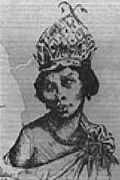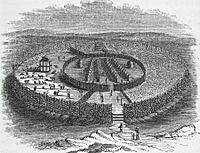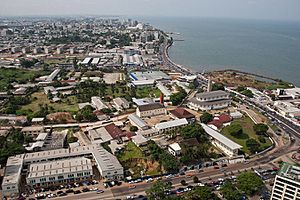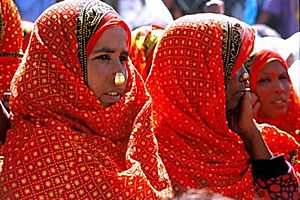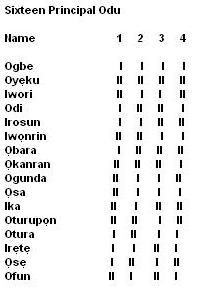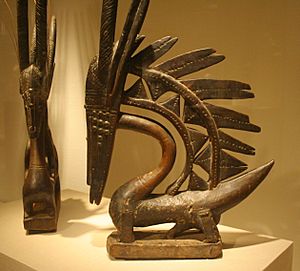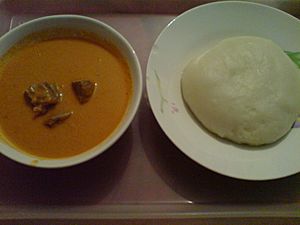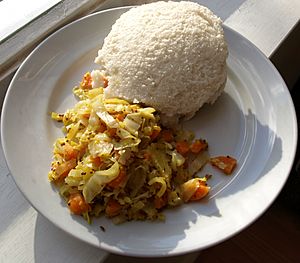Sub-Saharan Africa facts for kids
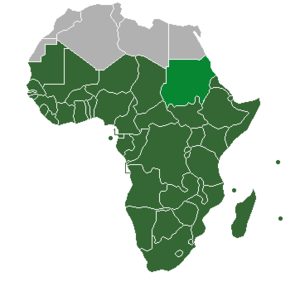
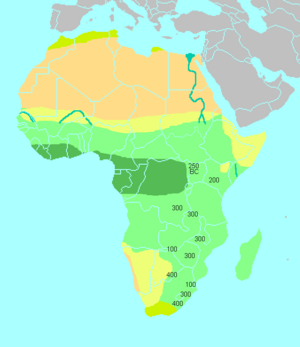
Sub-Saharan Africa is a huge part of the African continent that lies south of the Sahara Desert. When people talk about it politically, they usually mean all the African countries that are fully or partly south of the Sahara, but not Sudan. This area is different from North Africa, which is often seen as part of the Arab world. Some countries like Somalia, Djibouti, Comoros, and Mauritania are geographically in Sub-Saharan Africa but are also considered part of the Arab world.
The Sahel is a special area that acts like a bridge between the dry Sahara Desert and the greener tropical savannas to the south. For a very long time, the Sahara Desert has been a tough barrier separating the northern and southern parts of Africa. Only the Nile River in Sudan offered a way through, but even that was blocked by big waterfalls called cataracts. Scientists have a "Sahara Pump Theory" that explains how plants, animals, and even early humans moved out of Africa when the Sahara was wetter, with more lakes and rivers.
Contents
What's in a Name?
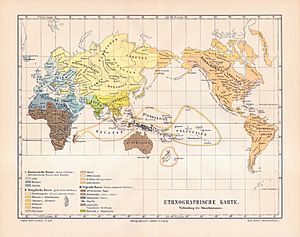
Long ago, geographers divided this region into different parts based on the people who lived there. In the Middle Ages, Arabic writers called a large area bilâd as-sûdân, which means "Land of the Blacks." This term was used for West and Central Africa. In Southeast Africa, a similar term was Zanj, meaning "Country of the Blacks." This area was near the African Great Lakes and was home to people who spoke Bantu languages.
Geographers also clearly separated these "Sudan" and "Zanj" regions from areas further east on the Red Sea coast. In what is now Ethiopia, there was Al-Habash or Abyssinia, where the Habesha lived. In northern Somalia, there was Barbara, or "Land of the Berbers." This was where the ancestors of the Somalis lived.
Climate Zones and Nature
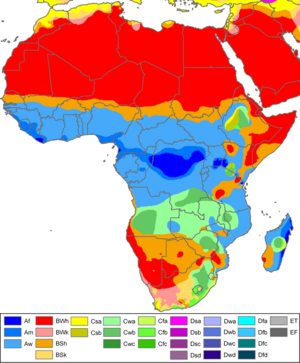
Sub-Saharan Africa has many different climate zones and natural areas, called biomes. Countries like South Africa and the Democratic Republic of the Congo are especially rich in different kinds of plants and animals.
- The Sahel stretches across Africa, acting as a border between the desert and greener lands. Countries like Mauritania, Mali, Niger, Chad, and Sudan have parts of both the Sahara and the Sahel.
- South of the Sahel, you find a wide belt of savanna, which are grasslands with scattered trees.
- The Horn of Africa has dry coastal areas but also moist broadleaf forests in the middle of Ethiopia.
- Africa's tropical rainforests are found along the southern coast of West Africa and cover much of Central Africa, especially the Democratic Republic of the Congo.
- The Serengeti ecosystem, famous for its wildlife, is in Tanzania and Kenya.
- The Kalahari Basin includes the Kalahari Desert, surrounded by drier lands.
- The Karoo is a semi-desert area in western South Africa.
History of Sub-Saharan Africa
Early Human History
Scientists believe that early human ancestors, called hominids, first appeared in Africa millions of years ago. These early hominids could walk on two legs, which was a big advantage. It helped them live in both forests and open grasslands as Africa's climate changed and became drier.
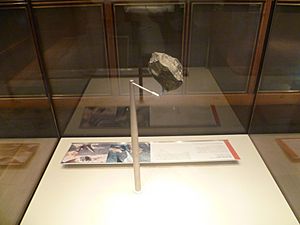
About 3 million years ago, several types of "southern apes" (australopithecines) lived across southern, eastern, and Central Africa. They used tools but didn't make them. Around 2.3 million years ago, a big step happened: early humans started using simple stone tools to get food, like scavenging meat from animals killed by other predators.
Later, about 1.8 million years ago, Homo ergaster appeared, and from them, Homo erectus (upright man) evolved. Homo erectus learned to make more complex stone tools and was possibly the first human ancestor to control fire. They were also the first to leave Africa, spreading across the Old World.
The oldest fossils of Homo sapiens (modern humans) show they lived in southern and eastern Africa at least 100,000 years ago. About 50,000 to 60,000 years ago, modern humans began to spread out of Africa, eventually colonizing the entire planet.
Even after the Sahara became a desert, people could still travel across it. They used animals like oxen, mules, and horses to carry water and supplies. Trade routes often followed chains of oases across the desert. Later, the introduction of camels made desert travel much easier.
Central Africa's Kingdoms
In the 14th century, the Luba Kingdom grew in the southeast Congo. Its kings had power because people believed they had spiritual authority. This kingdom controlled farming and trade in important goods like salt, iron, and copper.
Later, groups from the Luba Kingdom formed the Lunda Empire in the 16th century. Their ruler, the Mwata Yamyo, also gained power from being seen as a spiritual guardian. This idea of spiritual kings spread, and many new states in Central Africa claimed to be connected to the Lunda dynasties.
The Kingdom of Kongo was another important state, stretching from the Atlantic coast inland. By the 15th century, farming communities were united under a king called the Manikongo. Other significant kingdoms in Central Africa included the Kuba Kingdom, known for its raffia cloth, and the Kingdom of Ndongo.
East Africa's Empires
The Horn of Africa
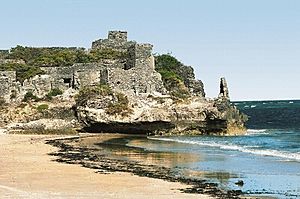
The Kingdom of Aksum was a powerful empire that existed along the western coast of the Red Sea, in what is now northern Ethiopia and Eritrea. Aksum was very important in the trade routes between India and the Mediterranean Sea. It became powerful around the 1st century AD. The Aksumites built huge stone monuments called stelae to mark the graves of their kings. Later, the Zagwe dynasty built churches carved directly out of solid rock, like the famous Church of St. George at Lalibela.

In ancient Somalia, city-states like Opone and Malao were busy trading centers. In the Middle Ages, powerful Somali empires, such as the Ajuran Sultanate, were known for their amazing water systems and strong forts. The Sultanate of Adal used cannons in battles, and the Gobroon Dynasty was so strong that even the Omani Empire paid them tribute.
In the late 19th century, European empires arrived in the Horn of Africa. This led to a long resistance war led by Muhammad Abdullah Hassan, a Somali leader who gathered soldiers to fight against the colonial armies.
Great Lakes Region
The African Great Lakes region is believed by many scientists to be where all modern humans first came from. Around 1,000 years ago, Nilotic and Bantu-speaking groups moved into this area. The Bantu-speaking people now make up most of Kenya's population.
Trade with Arab merchants helped create the Swahili culture along the Swahili coast of Kenya, Tanzania, and northern Mozambique. This coast was a major trading hub with Persia, China, the Arab world, and India, especially for ivory and slaves.
In 1498, Vasco da Gama was the first European to reach this coast. By 1525, the Portuguese took control of the Swahili Coast. However, in the early 18th century, Arabs from Oman helped the local people drive the Portuguese out. Most Great Lakes nations gained independence from colonial rule in the early 1960s.
Southern Africa's History
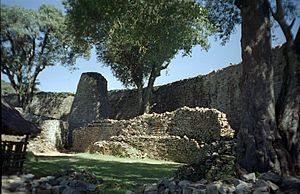
By the 4th or 5th century, Bantu-speaking people, who were farmers and herders using iron tools, had settled south of the Limpopo River. They slowly moved south, and the earliest iron tools in modern-day KwaZulu-Natal Province date back to around 1050. The southernmost group, the Xhosa, reached the Fish River in today's Eastern Cape Province.
Monomotapa was a medieval kingdom (around 1250–1629) located between the Zambezi River and Limpopo Rivers, in what is now Zimbabwe and Mozambique. Its old capital, Great Zimbabwe, has famous ruins.
In 1487, Bartolomeu Dias was the first European to reach the southern tip of Africa. In 1652, the Dutch East India Company set up a supply station at the Cape of Good Hope. This settlement slowly grew and was a Dutch possession for most of the 17th and 18th centuries.
Great Britain took control of the Cape of Good Hope in 1795. It was returned to the Dutch briefly but then annexed by the British in 1806. The Zulu Kingdom (1817–79) was a powerful tribal state in what is now South Africa, becoming famous during the Anglo-Zulu War. Most Sub-Saharan African nations gained independence from colonial rule in the 1950s and early 1960s.
Western Africa's Empires
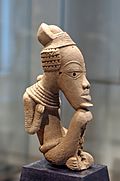
The Bantu expansion was a huge movement of people that started in West Africa around 2500 BCE. These people spread across East and Central Africa by 1000 BCE and reached Southern Africa in the early centuries AD.
The Nok culture in Nigeria is known for its terracotta figures, dating from 500 BCE to AD 200. Many medieval empires grew in the southern Sahara and Sahel regions, thanks to trade across the desert. These included the Ghana Empire, the Mali Empire, and the Songhai Empire. They built structures from stone, like in Tichit, but mostly used mud brick, known as adobe. The Great Mosque of Djenne is a famous example of Sahelian architecture and is the largest adobe building in the world.
In the forest areas, several states and empires also emerged. The Ashanti Empire appeared in the 16th century in modern-day Ghana and Côte d'Ivoire. The Kingdom of Nri in Nigeria, founded by the Igbo people in the 11th century, was unique because its priest-king had no military power and never traded in slaves.
Other important kingdoms included Ife and Oyo in western Nigeria, which became centers of Yoruba culture. The Yoruba built massive mud walls around their cities, like Sungbo's Eredo. The Kingdom of Benin was another powerful kingdom, known for its Walls of Benin, which are considered the largest human-made structure in the world.
In the 18th century, the Oyo and Aro confederacy were involved in the slave trade, with Great Britain, France, and Portugal being major buyers. After the Napoleonic Wars, the British expanded trade in Nigeria and eventually took control, making Nigeria a British protectorate by 1901. By 1960, most of the region gained independence from colonial rule.
People and Population
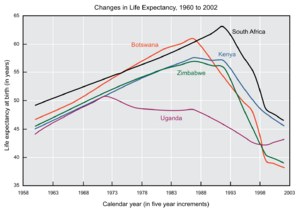
Sub-Saharan Africa faces challenges like Malaria, which slows down economic growth. The disease causes people to lose time from work or school and costs money for treatment. If malaria had been removed in 1960, the region's economy could have been much bigger.
In 2007, the population of Sub-Saharan Africa was 800 million. It is growing quickly, and the United Nations expects it to reach almost 1.5 billion by 2050. Many countries in this region have high birth rates. Life expectancy, nutrition, and child health are also big concerns. More than 40% of the people in Sub-Saharan countries are younger than 15 years old.
Sadly, Sub-Saharan Africa has a very high child mortality rate, meaning many children die before the age of five. While this rate has decreased, malaria is still a leading cause of death for children.
Money invested in Africa from other countries has grown a lot. Trade between Africa and the rest of the world, especially Asia, is also increasing. For example, trade between China and Africa jumped by 45% in 2008.
Economy and Resources
Energy and Power
About half of Africa's rural areas do not have electricity. The continent produces only a small fraction of the world's electricity. Many countries struggle with power shortages.
Because the prices of coal and oil are rising, other ways to make electricity are becoming too expensive. Sub-Saharan Africa plans to build many more hydropower plants, which use water to generate electricity. The region has a huge potential for hydropower, but only a small part of it is used. This is mainly because not enough money is invested in building the necessary infrastructure.
African governments are using their abundant water resources to create more energy. Asian countries like China, India, and Japan are helping with many power projects, especially hydropower, because they have a lot of experience in building them.
Sub-Saharan Africa also has a massive potential for solar power, especially since it has a lot of sunlight. This could provide electricity to hundreds of millions of people. China is even training African technicians to use solar energy.
Media and Communication
Radio is the main way people get information in Sub-Saharan Africa. More than a third of the population can access radio. In some countries, almost everyone has radio access. However, in a few countries, less than 10% of people have radio.
Television is the second most important source of information. But because of power shortages, not many people have televisions. Only about 8% of the population, or 62 million people, have TV. However, the television industry sees this region as a big new market for digital TV and paid services. Access to the internet through cell phones is also growing.
Infrastructure and Development
A lack of good infrastructure, like roads and power systems, is a big problem for economic growth in many developing countries. Less than 40% of people in rural Africa live near a road that can be used all year round. This is the lowest level of rural access in the developing world.
Investing in infrastructure can greatly help a country's economy. For example, investments in telecommunications can bring 30-40% returns, and roads can bring 80% returns. To meet important development goals by 2015, Africa would need to invest a lot more in infrastructure.
Money for infrastructure comes from different places. Governments spend some, but also from foreign aid and private investors. China, in particular, has become a very important investor in African infrastructure.
Oil and Minerals
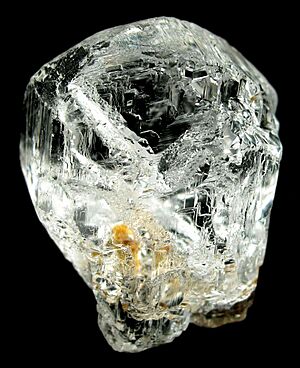
Sub-Saharan Africa is a major exporter of valuable minerals like gold, uranium, chrome, copper, and diamonds. South Africa is a top producer of platinum and has a large share of the world's chromium reserves. Zambia produces a lot of copper, and the Democratic Republic of Congo is a major source of coltan.
The region produces about 30% of the world's gold, with South Africa, Ghana, and Zimbabwe being big suppliers. Namibia is a key supplier of uranium. Sub-Saharan Africa also produces 49% of the world's diamonds.
By 2015, it was estimated that 25% of North American oil would come from Sub-Saharan Africa, more than from the Middle East. Even though it has only 10% of the world's proven oil reserves, Sub-Saharan Africa has become a major focus for countries like the West, China, and India looking for oil. This is sometimes called the "second Scramble for Africa." One reason is that most of the oil is offshore, so political problems on land don't directly affect oil operations. Also, the oil found here is easy to refine, which saves money.
Agriculture and Farming
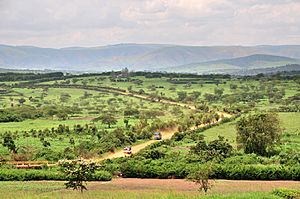
Sub-Saharan Africa has more different types of grains than anywhere else. People started collecting wild grains for food in the Nile region thousands of years ago. Many crops that are now grown worldwide were first domesticated in this region. These include sorghum, coffee, cotton, okra, black-eyed peas, watermelon, and millet. Other important crops include teff, African rice, and yams. Domesticated animals from this region include the guineafowl and the donkey.
Agriculture makes up a large part of the region's economy and employs most of its workers. Most farming is for people to feed themselves, which makes it vulnerable to climate change. Some people believe that using biotechnology to create stronger crops could help small farmers.
Cash crops, grown to be sold, include cotton, coffee, tea, cocoa, sugar, and tobacco. Experts say Africa could become a huge agricultural power if farmers can use their land to get loans. There's a lot of international interest in farming in Sub-Saharan Africa, with the World Bank increasing its funding for agricultural programs. Recently, some countries have been buying large areas of land in Sub-Saharan Africa for farming.
Health Care
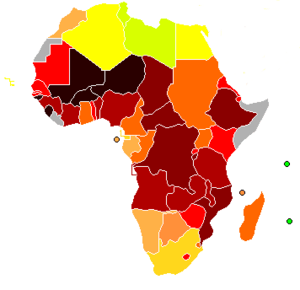
In 1987, a meeting called the Bamako Initiative helped change health policy in Sub-Saharan Africa. It made health care more accessible to communities, leading to better and fairer services. This approach improved health care across the region.
However, many governments still struggle to deal with the effects of the AIDS pandemic, even with many efforts to help.
Languages and People Groups
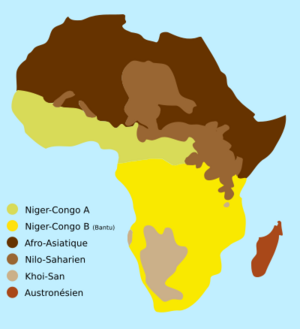
Sub-Saharan Africa has more different languages than any other region in the world. There are over 1,000 languages spoken here, which is about one-sixth of all the languages in the world!
The Afro-Asiatic languages family has the longest recorded history. Ancient Egyptian, for example, was written down as early as 3200 BCE. These languages are mostly found in North Africa and the Horn of Africa. Hausa is a very important language for trade and communication in West Africa.
The Khoisan languages are spoken by indigenous groups in Southern Africa and Tanzania, like the Khoi and San (Bushmen) people.
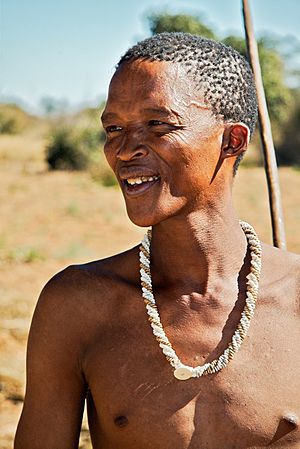
The Niger-Congo languages family is the largest in the world by the number of languages it includes (over 1,400!). Most of these languages use tones, meaning the meaning of a word can change based on the pitch of your voice. A big part of this family is the Bantu languages, which cover a huge area in southern, central, and southeastern Africa. Swahili, a Bantu language with many words from Arabic and Persian, became a common language for trade in southeastern Africa.
The Nilo-Saharan languages are found mainly along the Chari River and Nile River. They are spoken by Nilotic peoples and other groups in Sudan and West and Middle Africa.
South Africa has the largest populations of people of European, Indian, and mixed heritage (called "coloured" in South Africa). The people of Madagascar are mostly a mix of Austronesian (Pacific Islander) and African origins. Southern Sudan is home to Nilotic people.
Here are some major languages by region:
- Central Africa
- Niger–Congo: Kinyarwanda, Kongo, Tshiluba, Kirundi
- East Africa
-
- Horn of Africa
-
- Great Lakes region
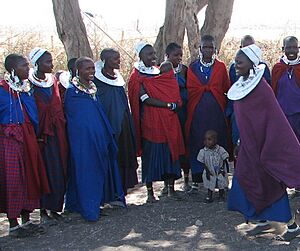
- Niger–Congo: Swahili, Chichewa, Gikuyu, Luhya
- Nilo-Saharan: Luo, Maasai
- Southern Africa
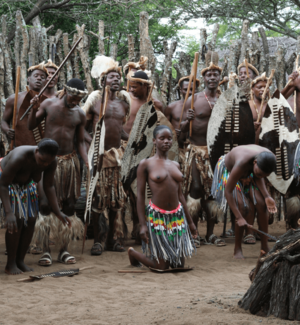
- Niger–Congo: Zulu, Xhosa, Shona, Sotho, Tswana, Umbundu, Northern Sotho
- Khoisan: Khoi
- Indo-European: Afrikaans
- Western Africa
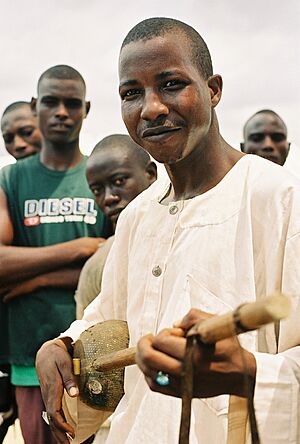
- Niger–Congo: Yoruba, Ibibio, Igbo, Akan, Fula, Mandingo, Wolof
- Afro-Asiatic: Hausa
- Nilo-Saharan: Kanuri, Songhai, Zarma
- Middle Africa
- Nilo-Saharan: Shilluk, Nubian, Fur, Dinka, Masalit, Zaghawa, Kanuri
- Niger-Congo: Zande, Gbaya
Religion
Most people in Sub-Saharan Africa are Christian, while North Africa is mostly Muslim. However, there are many Muslims in the Sahel and Sudan regions, and along the East African coast. Countries like the Gambia, Sierra Leone, Guinea, Mali, Niger, Senegal, and Somalia have Muslim majorities. In countries like Chad, Nigeria, Burkina Faso, and Côte d'Ivoire, there are similar numbers of Christians and Muslims.
Traditional African religions have common beliefs. Many believe in a creator God, ancestor spirits, and spirits of the land. They believe that bad things can happen if people have ill will or ignore ancestor spirits. New world religions like Santería and Vodun came from these traditional beliefs.
Traditional Sub-Saharan African religions have very complex ideas about the world and how it works. Their stories often show how difficult it was to bring order out of chaos. Order is seen as what is right and natural, and any deviation from it is chaos. These religions often talk about duality: material and immaterial, male and female, heaven and earth.
Music

Traditional Sub-Saharan African music is very diverse. Many people think of it as rhythmic music focused on drums, and that's partly true. A lot of music, especially among speakers of Niger-Congo languages and Nilo-Saharan languages, is indeed rhythmic and uses drums. This music is often polyrhythmic, meaning it has many rhythms playing at the same time. Dances involve moving many body parts. These musical styles have influenced music around the world, like Samba, Jazz, R&B, Rock & Roll, Salsa, Reggae, and Rap.
However, Sub-Saharan music also uses many string and horn instruments, sometimes with less focus on polyrhythms. Music from the eastern Sahel and along the Nile often used strings and horns in ancient times. Among Afro-Asiatic speakers, string instruments are common. Dancing in these areas often involves swaying body movements and footwork. The San people use many string instruments and focus on footwork in their dances.
Modern Sub-Saharan African music has been influenced by music from the New World, like Jazz and Salsa, just as African music influenced those styles. Popular modern styles include Mbalax in Senegal, Highlife in Ghana, Makossa in Cameroon, Soukous in the Democratic Republic of the Congo, and Mbaqanga in South Africa.
Art
The oldest abstract art in the world is a shell necklace from Morocco, dated 82,000 years ago. The oldest rock art is found in South Africa, dated 77,000 years ago. Sub-Saharan Africa has some of the oldest and most varied rock art styles.
Even though Sub-Saharan African art is very diverse, there are some common themes. One is the use of the human figure. Another is a preference for sculpture. African art is often meant to be seen and experienced in three dimensions, like a house that you can walk around. Art is also often meant to be performed. For example, the name for a mask might include the sculpture itself, the dance it's used in, and the spirit it represents.
African art often serves a practical purpose; artists and craftspeople are not separate. A sculpture shaped like a hand might also be used as a stool. Another common feature is the use of fractals, where the shape of the whole is similar to the shape of its parts at different sizes.
Finally, Sub-Saharan African art is often visually abstract rather than realistic. It represents spiritual ideas, social rules, and values. An artist might make a sculpture's head larger than its body not because they don't know anatomy, but to show that the head is where knowledge and wisdom come from. This abstract style greatly influenced famous modernist artists like Pablo Picasso and Henri Matisse.
Cuisine
Sub-Saharan African cuisine is very diverse, with different regions having their own main dishes and flavors.
West African food is often starchy and spicy. Common dishes include fufu, kenkey, and garri. Ingredients often come from starchy root vegetables like yams and cassava. Grains like millet, sorghum, and rice are also used, especially in the Sahel. Palm oil and shea butter are common cooking oils. Many recipes mix fish and meat. Popular drinks include palm wine and millet beer. Cooking methods include roasting, baking, boiling, frying, and mashing.
Southeast African cuisine, especially among the Swahilis, shows influences from Islamic and Indian Ocean cultures. Dishes like ugali and halva are common. Spices such as curry, saffron, cloves, and cinnamon are used, especially by Muslims. Meat like cattle, sheep, and goats is eaten, but often seen as a sign of wealth rather than just food.
In the Horn of Africa, Christians and Muslims avoid pork and non-fish seafood. Ethiopians also avoid dairy and all meats during Lent. Maize (corn) is a main food, used to make ugali. Teff is used to make a bread called injera. Other important foods include enset, lentils, rice, bananas, and leafy greens. Coffee, which originated in Ethiopia, is a popular drink, as is chai tea.
Central African cuisine connects with all major regions of Sub-Saharan Africa. It is often starchy and spicy. Main crops include plantains, cassava, peanuts, and okra. Meats include beef, chicken, and sometimes exotic "bush meat" like antelope. Spicy fish dishes are very popular. Mushrooms are sometimes used as a meat substitute.
Traditional Southern African cuisine often focuses on meat. Historically, societies raised sheep, goats, and cattle. Dishes include braai (barbecue meat), sadza, and milk products. Common crops are sorghum, maize, pumpkin, and leafy greens. Drinks include fermented sorghum or maize drinks, and milky beer. Indian and Malay influences can be seen in dishes like curries and samosa. European influences include biltong (dried beef strips) and French wines.
Clothing
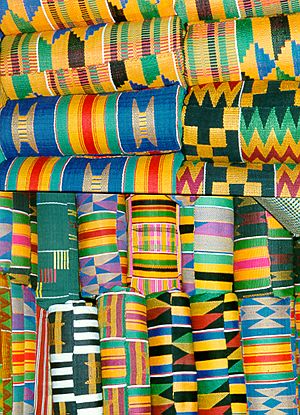
Like many parts of the world, people in Sub-Saharan Africa wear Western-style clothing. However, the region also has its own traditional clothing styles, often made from cotton.
In East Africa, cotton clothing is widely used. Shemma, shama, and kuta are types of Ethiopian clothing. Kanga are rectangular cloths made of pure cotton, used to create clothing by the Swahili people. Kitenges are similar but thicker and are worn in countries like Kenya, Uganda, Tanzania, and South Sudan. In Malawi, Namibia, and Zambia, they are called Chitenge. A unique material used for clothing is barkcloth, made from the Mutuba tree by the Baganda people of Uganda. On Madagascar, a draped cloth called lamba is worn.
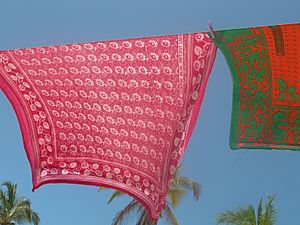
In West Africa, cotton is also the main material. In the Sahel, styles like the boubou and kaftan are popular. Kente cloth is made by the Akan people of Ghana and Côte d'Ivoire from silk. Kente means "basket" in the Twi language. It is sometimes used to make dashiki and kufi. Adire is a type of Yoruba cloth with special patterns. Raffia cloth and barkcloth are also used.
In Central Africa, the Kuba people developed raffia cloth from raffia plant fibers, which was widely used. Barkcloth was also common.
In Southern Africa, animal hides and skins are often used for clothing. The Ndau and Shona people mix hide with barkcloth and cotton. The Xhosa, Tswana, Sotho, and Swazi people also use hides from cattle, sheep, goats, and even elephants. Leopard skins were highly valued and symbolized kingship in Zulu society. Skins were tanned, dyed, and decorated with beads.
Images for kids
-
Historic ethnographic map depicting the Sudan region and its eastern equivalent Zanj in brown tones. The contrasting Al-Habash and Barbara regions are shown in shaded blue.
-
Stone chopping tool from Olduvai Gorge.
-
Nzinga Mbande, queen of the Kingdom of Ndongo and Kingdom of Matamba.
-
Stone city of Gondershe, Somalia.
-
Fasilides Castle, Ethiopia.
-
Nok sculpture, terracotta, Louvre.
-
Life expectancy has fallen drastically in Southern Africa since the 1990s as a result of HIV.
-
The Athlone Power Station in Cape Town, South Africa.
-
Skyline of Libreville, Gabon.
-
Phenakite from the Jos Plateau, Plateau State, Nigeria.
-
Agricultural fields in Rwanda's Eastern Province.
-
Map of Africa indicating Human Development Index (2004). All 22 countries ranking below 0.5 in the report on 2005 were in Sub-Saharan Africa. The highest value is that of Gabon at 0.677.
-
Linguistically, sub-Saharan Africa is dominated by the Niger–Congo family (distribution shown in yellow), with pockets of Khoi-San families in Southern Africa, Nilo-Saharan in Central and East Africa, and Afro-Asiatic in the Horn of Africa.
-
A San tribesman.
-
Maasai women and children.
-
Zulus in traditional garment.
-
A Hausa harpist.
-
A traditional polyrhythmic kalimba.
-
A plate of fufu accompanied with peanut soup.
-
The Ashanti Kente cloth patterns.
See also
 In Spanish: África subsahariana para niños
In Spanish: África subsahariana para niños


